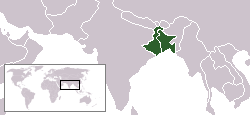Partition of Bengal (1947)
- For the 1905 partition, see 1905 Partition of Bengal
The Partition of Bengal in 1947 divided Bengal into the two separate entities of West Bengal belonging to India, and East Bengal belonging to Pakistan. This was part of the Partition of India and officially took place August 14, 1947 - August 15, 1947. East Bengal was renamed East Pakistan, and later became the independent nation of Bangladesh after the Bangladesh Liberation War of 1971.
Background
As the Indian independence movement gained momentum, Britain also lost her will to govern India. When Clement Attlee's new Labour administration came to power in July 1945, Lord Mounbatten was quickly appointed Governor-General of India with instructions to end colonial rule as soon as possible. He was appointed 21 February 1947. The independence struggle was Indian National Congress, which had originally campaigned for increased Indian participation in governance. However, since 1905, full independence had become the only acceptable goal. The failed 1905 Partition of Bengal was a crucial catalyst in shifting Indian opinion away from limited self-governance towards complete independence.
Allegedly an administrative convenience in order to deliver better governance to the large and populous province of Bengal, the 1905 partition divided the Hindu majority West from the Muslim majority East, although substantial minorities remained on either side. The 1905 partition was popular among the Muslims in the East, who now had their own province. However, Hindus on both sides of the divided province opposed partition. A series of demonstrations, strikes and a boycott of British goods began, with support from across India. Partition was seen as an act of colonial arrogance and blamed on the divide and rule policy. "Calcutta," says Metcalf, "came alive with rallies, bonfires of foreign goods, petitions, newspapers and posters." Anti-British and pro-self-rule sentiment increased.[1] In fact, the Swadeshi movement itself emerged from opposition to Partition, which was regarded as "a sinister imperial design to cripple the Bengali led nationalist movement."[2]
Hindu Bengalis were among the most vocal proponents of Indian nationalism. Many of the "Hindus who were considered "unfriendly if not seditious in character" lived in the east" and dominated "the whole tone of Bengal administration."[3] By dividing the province, the British hoped to muzzle their voice since they would find themselves surrounded by a Muslim majority. The plan backfired. Instead of muzzling the proponents of independence, the movement gathered momentum across India. The INC began to actively promote swaraj (self-rule), swadeshi (self-sufficiency) and national pride.
However, as a result of partition, the Muslims in the East began to develop their own distinctive identity as a social-economic community, in distinction from their Hindu neighbors despite the fact that previously many Bengalis from both religions had favored Bengali nationalism. Although Partition was annulled in 1911, Muslims in the East had a taste of what it was like to dominate the legislature.[4] In 1906, at Dhaka capital of what was still East Bengal, the Muslim League was formed with the explicit purpose of defending the interests of the Muslims of India should Hindus choose to undermine these, either in an India where Indians had a greater role in governance or in an independent India where they would constitute a majority. By 1916, the League and the INC agreed that separate constituencies should be established to protect communitarian interests. This became law in 1919. At the Muslim League conference in 1930, the philosopher-poet-politician, Muhammad Iqbal first proposed the idea of a separate state for Muslims. In that this would consist of majority-Muslim areas, which would have to be partitioned off from Hindu-majority areas, it took its cue from the 1905 Partition of Bengal. Some geographical specificity was given to the nation of a separate Muslim state by Choudhary Rahmat Ali in "Now or Never; Are We to Live or Perish Forever?" (January 28, 1933) suggesting that a state called Pakistan could be formed from Punjab, Afghanistan Province, Kashmir, Sind, Baluchistan.
Bibliography
- Baxter, Craig. 1997. Bangladesh: from a nation to a state. Nations of the modern world. Boulder, CO: Westview Press. ISBN 9780813328546.
- Chatterji, Joya. 1994. Bengal divided: Hindu communalism and partition, 1932-1947. Cambridge South Asian studies. Cambridge, [England]: Cambridge University Press. ISBN 9780521411288
- Edwards, Philip. 2004. Shakespeare and the confines of art. Routledge library editions. London: Routledge.
- Gyanendra Pandey Remembering Partition: Violence, Nationalism, and History in India. Cambridge: Cambridge University Press, 2001. ISBN 0521002508
- Mukhopādhyāẏa, Kālīprasāda. 2007. Partition, Bengal and after: the great tragedy of India. New Delhi: Reference Press. ISBN 9788184050349
- Kamra, Sukeshi. 2002. Bearing witness partition, independence, end of the Raj. Calgary, Alta: University of Calgary Press. ISBN 9780585402772
- Tai Yong Tan and Gyanesh Kudaisya The Aftermath of Partition in South Asia. London: Routledge, 2001. ISBN 0415172977
See also
2001 Indian-Bangladeshi border conflict
External links
- "Partition of Bengal, 1947" from Banglapedia (Boi Mela)
- Partition Studies.
Template:Bangladesh-hist-stub Template:India-stub Template:Pakistan-stub
Credits
New World Encyclopedia writers and editors rewrote and completed the Wikipedia article in accordance with New World Encyclopedia standards. This article abides by terms of the Creative Commons CC-by-sa 3.0 License (CC-by-sa), which may be used and disseminated with proper attribution. Credit is due under the terms of this license that can reference both the New World Encyclopedia contributors and the selfless volunteer contributors of the Wikimedia Foundation. To cite this article click here for a list of acceptable citing formats.The history of earlier contributions by wikipedians is accessible to researchers here:
The history of this article since it was imported to New World Encyclopedia:
Note: Some restrictions may apply to use of individual images which are separately licensed.
